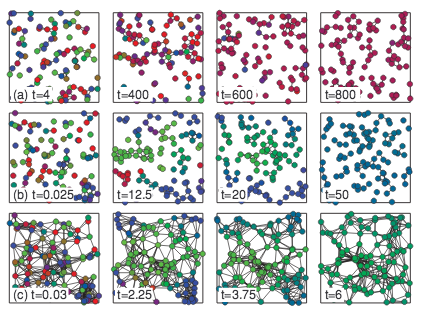Synchronization in complex networks

Albert Diaz-Guilera
Concerning again the complex patterns of interactions that have been found in many natural, social and technological systems, we have studied the interplay between dynamics and topology. In particular:
-
Hierarchically organized networks: We have focused our research on the way topology, in terms of the communities that are formed at different scales, affects the dynamics of the complete system, in terms of the partial synchronization achieved between the different topological groups. We have modelized the dynamics through the Kuramoto model for which a stationary solution in which all the oscillators are completelly synchronized exists. Click here for a more detailed information and application to several computer-generated networks.
-
Nonidentical oscillators: Further applications of synchronization have been addressed to nonidentical oscillators. On one hand we have looked at a bipolar distribution of frequencies and analyzed the effect of clustering of identical units, which can be important in the stability of power-systems. On the other hand we have studied the effect of singular oscillators (pacemakers or regulators) on the global dynamics of the system.
-
Mobile oscillators: More recently we are looking at agents/oscillators that can move on a plane. The interplay between the motion and the phases updates play crucial role that can be analyzed in terms of semi-analytical approaches. Follow this link for an applet.
Collaborations:
- J.A. Almendral, Universidad Rey Juan Carlos
- A. Arenas, Universitat Rovira i Virgili
- L. Buzna, ETH Zurich
- N. Fujiwara, Potsdam Institute of Climatology
- J. Gómez-Gardeñes, URJC
- J. Kurths, Potsdam Institute of Climatology
- S. Lozano, ETH Zurich
- Y. Moreno, BIFI
- C.J. Pérez, Universitat de Barcelona
- L. Prignano, Universitat de Barcelona
- O. Sagarra, Universitat de Barcelona



